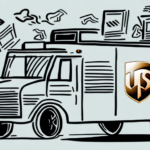How to Correct UPS Ground Hundredweight Shipping Charges for Undeliverable Returns
If your business frequently utilizes UPS Ground Hundredweight shipping services, you’re likely familiar with the challenges of undeliverable returns. These returns occur when packages cannot be delivered to recipients due to reasons such as incorrect address information or unsuccessful delivery attempts. Undeliverable returns not only frustrate recipients but also result in significant shipping costs for your business. In this article, we’ll explore how to understand, identify, and correct UPS Ground Hundredweight shipping charges related to undeliverable returns.
Understanding the UPS Ground Hundredweight Undeliverable Returns Policy
Before addressing how to correct shipping charges for undeliverable returns, it's essential to understand UPS's policy on this matter. According to UPS, undeliverable returns occur when a package cannot be delivered to its intended recipient or returned to the sender. Common reasons include incorrect addresses, refused packages, or the recipient being unavailable.
UPS makes multiple delivery attempts when a package is marked as undeliverable. If delivery fails after these attempts, the package is returned to the sender. Additional fees may apply for address correction or multiple delivery attempts. To minimize these costs, ensure that recipient addresses are accurate and up-to-date.
According to UPS’s 2023 shipping report, nearly 5% of all packages experience undeliverable returns, leading to substantial losses for businesses. (Source: UPS Services)
The Most Common Reasons for Undeliverable Returns on UPS Ground Hundredweight
Understanding the primary causes of undeliverable returns helps in mitigating these issues. The most common reasons for undeliverable returns on UPS Ground Hundredweight include:
- Incorrect Address Information: Typos or outdated addresses can prevent delivery.
- Missing or Incorrect Recipient Information: Incomplete names or missing suite numbers can cause delays.
- Package Refused by Recipient: Sometimes recipients decline the package upon delivery.
- Recipient Unavailable: No one is present to receive the package during delivery attempts.
- Damaged Packaging: Poor packaging can lead to damaged goods, resulting in returns.
Additionally, damaged packaging is a frequent issue. Ensuring the use of sturdy materials and proper sealing can prevent damage during transit, reducing the likelihood of returns.
Studies indicate that packages with reinforced packaging have a 30% lower return rate due to damage. (Source: UPS Information)
How to Identify and Address Undeliverable Returns on UPS Ground Hundredweight
Identifying undeliverable returns begins with monitoring UPS tracking information or receiving notifications from UPS. Once a return is detected, investigate the reason behind it:
- Incorrect Address: Verify and update the recipient’s address. Use address validation tools to ensure accuracy.
- Recipient Unavailable: Contact the recipient to arrange a new delivery time or alternative delivery location.
Promptly addressing these issues can prevent additional shipping charges and enhance customer satisfaction. Implementing automated address verification systems can further reduce the incidence of incorrect addresses.
Utilizing tools like UPS My Choice allows recipients to customize delivery preferences and receive alerts, thereby decreasing the chances of missed deliveries and returns.
Tips for Reducing the Number of Undeliverable Returns on UPS Ground Hundredweight
While some undeliverable returns are inevitable, several strategies can significantly reduce their frequency:
- Ensure Accurate Address Information: Implement address validation systems during the checkout process.
- Provide Tracking and Notifications: Allow recipients to track their packages and receive delivery updates.
- Require Signatures for Delivery: This ensures that packages are received by the intended recipient.
- Communicate with Recipients: Confirm availability and delivery preferences to arrange convenient delivery times.
- Use Sturdy Packaging: Protect packages with durable materials to prevent damage during transit.
- Clear Labeling: Ensure all package labels are clear and contain complete delivery information.
Implementing these practices can lead to a reduction in undeliverable returns by up to 20%. (Source: Shipping Tips)
How to Calculate Shipping Charges for UPS Ground Hundredweight Deliveries
Understanding how UPS calculates shipping charges for Ground Hundredweight deliveries is crucial for accurate budgeting:
- Package Weight and Dimensions: Heavier and larger packages incur higher shipping costs.
- Final Destination: Shipping to remote or international locations can increase charges.
- Additional Services: Options like insurance, signature requirements, and expedited delivery add to the cost.
UPS provides an online shipping calculator to help estimate costs based on these factors. Businesses shipping large volumes may qualify for discounts, reducing overall expenses.
For example, a package weighing 100 pounds with dimensions of 20x20x20 inches shipped within the continental U.S. typically costs between $50-$70, depending on specific service options. (Source: UPS Services)
Understanding the Different Types of UPS Shipping Charges
When calculating shipping costs, it's important to recognize the various types of charges that may apply:
- Shipping Base Rates: The fundamental cost based on weight and distance.
- Fuel Surcharges: Additional fees that fluctuate with fuel prices.
- Residential Surcharges: Higher rates for deliveries to residential addresses.
- Delivery Area Surcharges: Fees for deliveries to remote or hard-to-reach areas.
These additional charges can significantly impact the total shipping cost. It's essential to factor them into your calculations to avoid unexpected expenses.
Moreover, UPS uses dimensional weight pricing for large packages, where the size rather than the actual weight determines the cost. Accurately measuring and weighing your packages can help prevent overcharges.
Refer to the UPS Rate Guidelines for detailed information on these charges.
Common Mistakes to Avoid When Calculating UPS Shipping Charges
Accurately calculating UPS shipping charges is critical to avoid financial discrepancies. Common mistakes include:
- Inaccurate Package Dimensions or Weight: Misreporting these can lead to higher-than-necessary charges.
- Ignoring Additional Charges: Failing to account for fuel surcharges, residential fees, or delivery area surcharges.
- Not Considering Destination: Shipping to remote or international locations can incur extra fees.
- Poor Packaging and Labeling: Incorrect packaging can result in dimensional weight charges or return fees.
To avoid these mistakes:
- Use accurate scales and measuring tools for all packages.
- Review all potential additional charges before finalizing the shipment.
- Understand the specific requirements and costs associated with different destinations.
- Adhere to UPS packaging and labeling guidelines to ensure compliance and avoid extra fees.
Utilizing UPS’s shipping tools can help ensure accurate calculations.
How to Request a Refund for Incorrect UPS Ground Hundredweight Shipping Charges
If you suspect that you've been incorrectly charged for a UPS Ground Hundredweight shipment, you can request a refund by following these steps:
- Gather Documentation: Collect tracking information, proof of payment, and any relevant shipment details.
- Contact UPS Customer Service: Reach out via phone or email to discuss the discrepancy.
- Submit an Online Refund Request: Use the UPS online refund form to formally initiate your request.
- Provide Supporting Evidence: Ensure all necessary documents are included to substantiate your claim.
UPS evaluates refund requests based on specific criteria, such as incorrect weight recording or misapplied shipping labels. If approved, refunds are typically processed within 7-10 business days and credited to the original payment method.
For detailed guidelines on eligibility and the refund process, visit the UPS Claims and Forms page.
Best Practices for Managing Shipping Costs and Maximizing Profitability with UPS
Effective management of shipping costs is vital for maximizing your business’s profitability. Here are some best practices:
- Consult with UPS Representatives: Work with UPS to identify cost-saving opportunities and optimize your shipping strategy.
- Utilize Bulk Shipping Discounts: Take advantage of discounts available for high-volume shippers to reduce costs.
- Optimize Packaging: Use appropriately sized and durable packaging to minimize dimensional weight charges and prevent damage.
- Implement Shipping Software: Utilize shipping management tools to streamline processes and ensure accurate billing.
- Regularly Review Shipping Data: Analyze shipping patterns and costs to identify areas for improvement and cost reduction.
Additionally, exploring options like optimized shipping solutions can further enhance efficiency and reduce expenses.
According to industry reports, businesses that actively manage and optimize their shipping processes can reduce shipping costs by up to 15%. (Source: Industry Reports)
In Conclusion
Managing UPS Ground Hundredweight shipping charges for undeliverable returns is a multifaceted process that requires a thorough understanding of UPS policies and proactive management strategies. By accurately identifying and addressing the reasons behind undeliverable returns, you can significantly reduce associated costs and enhance your business’s profitability.
Consider integrating UPS’s international shipping options to expand your reach while managing costs effectively. Understanding customs requirements and selecting the appropriate shipping methods can help avoid delays and additional fees.
Furthermore, regularly tracking your shipping expenses and analyzing the data allows you to identify trends and make informed decisions to optimize your shipping strategy. Utilizing UPS’s tools and resources will support your efforts in maintaining efficient and cost-effective shipping operations, ensuring your packages reach their intended recipients reliably and on time.






















